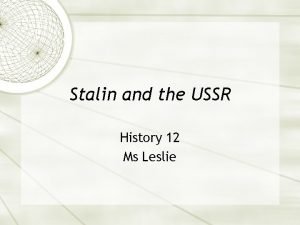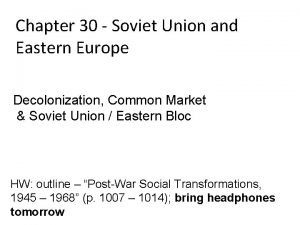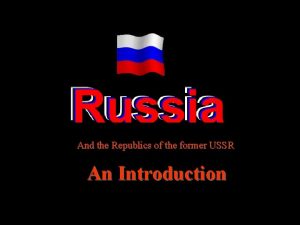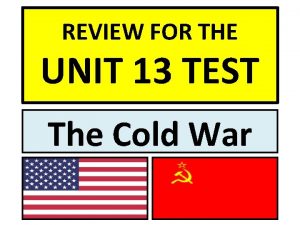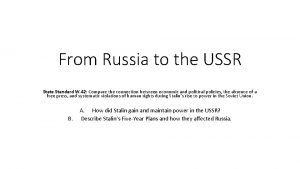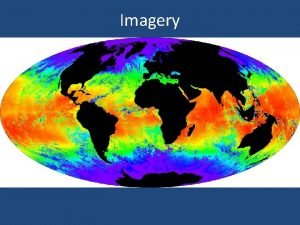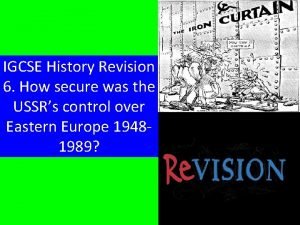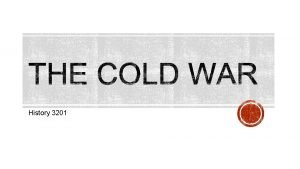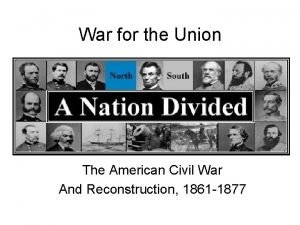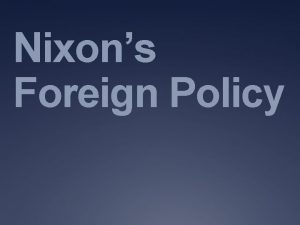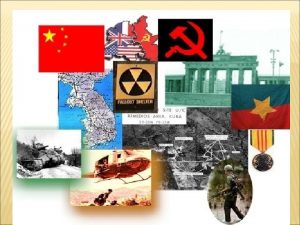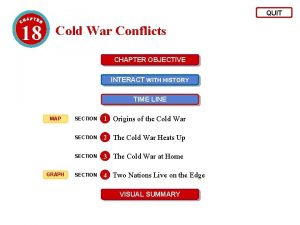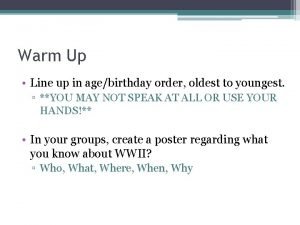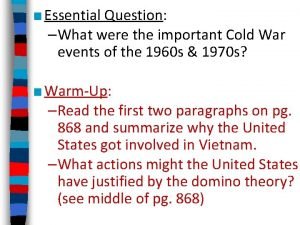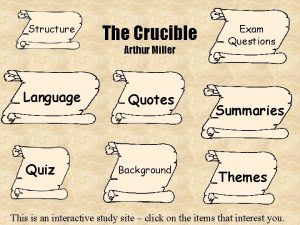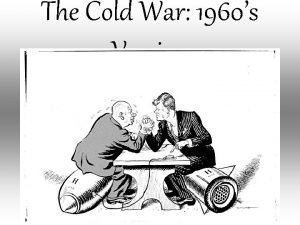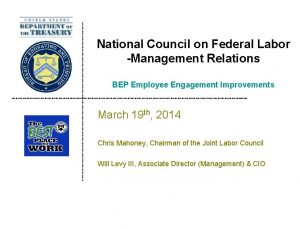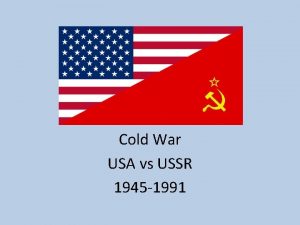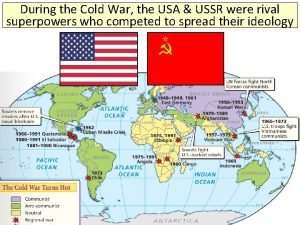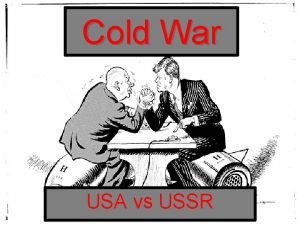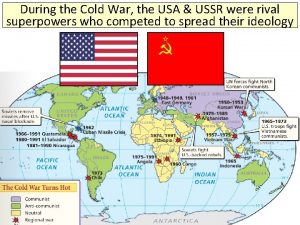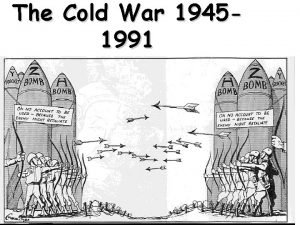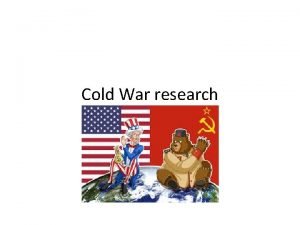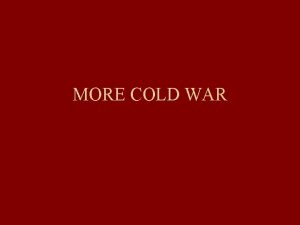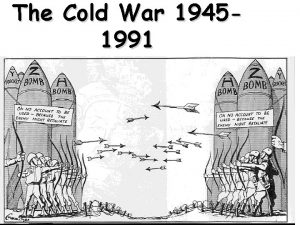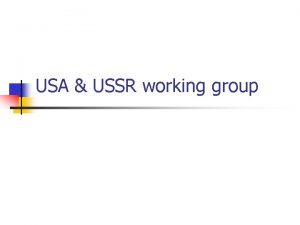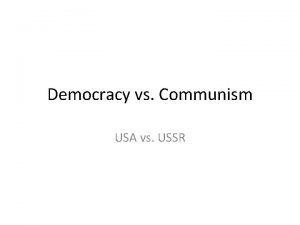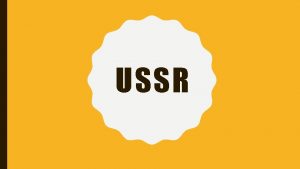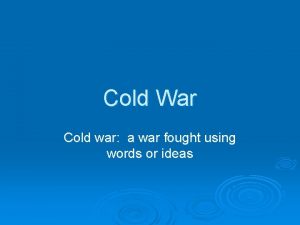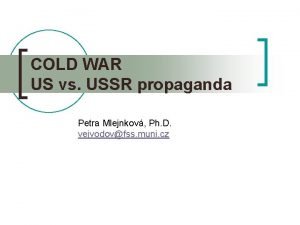The Cold War USA vs USSR What is



















- Slides: 19

The Cold War USA vs USSR

What is the Cold War? • After WWII most of the world’s superpowers were in debt and without influence. The two nations left to lead the world were USA and Russia (creating a bipolar world) • Unfortunately, these two giants were at odds with each other over their core ideologies. • USA was staunchly capitalist and democratic and Russia was a communist dictatorship. • The next 40 years was the fight between these two nations for world influence. • It is called the Cold War because these two superpowers never actually declared war on each other and never actually physically battled.


Nuclear Parity n n n Why didn’t USA and USSR go to war? The invention of nuclear weapons meant that if war was declared, world annihilation was a real possibility. Both superpowers had nuclear technology (nuclear parity or equality) and so fought for influence instead.

Tensions • USA was suspicious of Soviet communism because it feared revolution and the destruction of Western Society • The Soviet Union was distrustful of the Western powers and feared an attempt to invade Soviet territory. • The Soviet Union took over 6 surrounding countries into its communist “Iron Curtain” to create a buffer zone between capitalist Western Europe and Communist Russia. • The USA went on a “witch hunt” of sorts to root out an communist spies within the country.


1945 • Canada had an impact in kicking off the Cold War with a man named Igor Gouzenko. • This man had evidence that the Russians had a spy ring within Canada (trying to get info on atomic technology in the US) • Canada offered Gouzenko protection if he gave up info on the spies. He did, and this was used to arrest 18 people suspected of Soviet ties. • The Cold War was on, and Canada was involved.

The Red Scare • • The 40 s and 50 s in the USA was full of anticommunist propaganda and hysteria. Everyone was a possible suspect in the Red Scare – the term given to the fear of communism within the country. Canada did not have the same communist frenzy as its neighbour, but some politicians did promote screening and other red scare tactics. Many artists, peace activists, and government critics were targeted.

NATO • North Atlantic Treaty Organization • Tensions in the recently divided Germany and specifically Berlin, prompted the Western powers to form NATO • This organization was a military alliance based on the idea that an attack on one member was an attack on them all. If necessary, total nuclear was a possibility. • The goal was to protect Western countries from a Soviet invasion. • Fully committed members of the alliance included Great Britain, USA, and Canada, just to name a few.

Warsaw Pact • When West Germany joined NATO, the Soviet Union felt threatened. • In response, they created the Warsaw Pact, made up of Eastern countries. Its purpose was the same as NATO but for communism.

The Northern Hemisphere was now divided into two aggressive camps that were set up and practicing for war. Spy rings were set up everywhere (James Bond!) and revolutions were abundant. Most significantly, the Berlin Wall was created to divide the city between capitalist West Berlin and communist East Berlin. It was to become a powerful symbol of the Cold War

How does this affect Canada? u All major wars had previously been fought on European soil. The invention of long range weapons, however, meant that the Soviet Union could easily target North America directly – over the North Pole.

>As protection, Canada and the US set up three lines of radar detection on Canadian soil: The Pinetree Line, the Mid-Canada Line, and the DEW Line. These lines would give enough warning to the USA to form a counterattack. >Some Canadians felt that having these US radar lines and US personnel in Canada compromised the country’s independence. Most Canadians, however, felt that it was worth it in order to stay safe.

• Soon, however, the Uss. R developed intercontinental Ballistic missiles that could reach North America in 30 minutes. • Defense now had to be bumped up – North American Air Defence (NORAD) was set up. Fighter forces and missile bases were set up in the US and Canada and 1000 Bombers were at its disposal at any given time.

• The threat of nuclear war became a genuine worry for people in the 1950 s. • Schools practiced “duck and cover” drills and families built nuclear shelters. • The whole world was preparing for nuclear war. • Duck and cover video




 Lesson 1 the cold war begins
Lesson 1 the cold war begins Usa ussr
Usa ussr Ussr
Ussr Proxy war cold war definition
Proxy war cold war definition Arms race
Arms race Ussr
Ussr Unit 13 test a
Unit 13 test a How did stalin gain and maintain power in the ussr?
How did stalin gain and maintain power in the ussr? Ussr first satellite
Ussr first satellite Igcse history chapter 6
Igcse history chapter 6 The cold war
The cold war Civil war usa
Civil war usa Nixons vietnamization policy
Nixons vietnamization policy Communism cold war
Communism cold war Cold war tension graph
Cold war tension graph Acrostic poem
Acrostic poem Brinkmanship cold war
Brinkmanship cold war Hysteria in the crucible
Hysteria in the crucible World war 1 jeopardy
World war 1 jeopardy Cold war
Cold war

